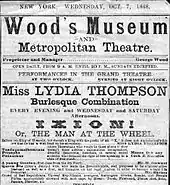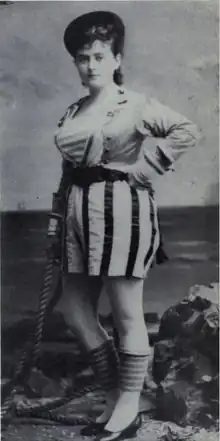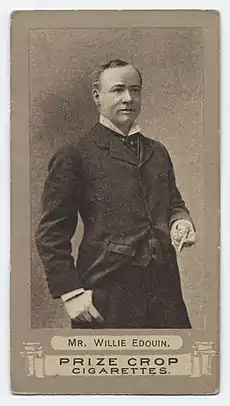Alice Atherton
Alice Atherton (c. 1854 – February 4, 1899), was a dancer, comedian, actress, and theatrical performer during the late 19th century.[1][2]
Alice Atherton | |
|---|---|
_for_Virginia_Brights_Cigarettes_MET_DP831873.jpg.webp) | |
| Born | c. 1854 |
| Died | February 4, 1899 |
| Nationality | American |
| Occupation(s) | Actress, singer and dancer |
Early years
Born Alice Atherton Hogan in Cincinnati; she was the daughter of William Hogan (1827–1907)[3] and Sarah Bennett. Her family resided in Cincinnati (1860 census) with her Kentucky born father's profession being listed as a brush maker.
Atherton had a gift for impersonation from a young age. Her career began as a child actress, carried on as a baby in "The Sea of Ice", at the Robinson’s Opera House in her home city, Cincinnati. Some obituaries refer to her as having been born in St. Louis; her place of marriage.[4]
Career
Atherton was discovered by Lydia Thompson, an English dancer, comedian, actress, and theatrical producer, who is recognized for introducing Victorian burlesque to the United States in August 1868, to great acclaim and notoriety.[5]
Atherton was enrolled as one of her girls in "Ixion". This was Thompson's first U.S. show and it was a huge success. It included wit, parody, song, dance, spectacle, music, and it has since been said it even empowered women.

This launched her career and that of several actresses, including Lisa Weber, and Rose Coghlan. It also drew fierce criticism from those who felt it transgressed the boundaries of propriety at the time. Burlesques, colloquially referred to as leg-shows, started off very tame, clever, and sophisticated, drawing in all types of people, especially women. Unfortunately, “the female audiences for burlesque did not last for long. In the summer of 1869 a wave of ‘anti-burlesque hysteria’ in the New York press frightened away the middle-class audiences that had initially been drawn to Ixion and sent the Thompson troupe prematurely packing on a tour around the United States and Canada.
Other shows followed, such as "Sinbad" and Atherton went on to become recognized as one of the best-natured, adventurous performers of the stage during the 1870s–1890s.[6][7]

Atherton’s versatility as a performer became legendary, as a comic singer, a virtuoso whistler, and her "laughing song" became her signature piece.[8] Though a parodist, she also excelled in comic roles that did not require playing a type.[9][10][11]
Atherton meets Willie Edouin

William Frederick Bryer (1846-1908), who went by the stage name of Willie Edouin[12] began a notable association with Lydia Thompson, playing with her burlesque troupe at Wood's Museum, New York, in October and November 1870. In the company was a sixteen-year-old Atherton.[13] Three years later she married her English co-performer, Willie, on December 27, 1873, in St Louis.[14] Together they became mainstays of the Coville burlesque companies. He organized the entertainment "Dreams, or Fun in the Photograph Gallery," a piece that showed off her skill for impersonation and popularized the comic skit as a stage form.[15][16]
Atherton’s image on promotional picture cards
According to The Metropolitan Museum of Art, in NYC, which displays her cards, they were issued between 1880 and 1892 by Thomas H. Hall Tobacco, in order to promote stage actors between the acts as well as the brand called Bravo Cigarettes.[17]
_for_Virginia_Brights_Cigarettes_MET_DP828880.jpg.webp)
_for_Virginia_Brights_Cigarettes_MET_DP830926.jpg.webp)
_for_Dixie_Cigarettes_MET_DP831271.jpg.webp)
Move to England
Atherton moved to London with her English husband in 1883.[18][19] There she would spend the majority of the final decade and a half of her career in music halls.[20][21] During this period, Meyer Lutz, the German-born British composer and conductor who is best known for light music, musical theatre and burlesques of well-known works composed the popular song "Eyes of English Blue" for her.
In 1885 she took to the stage at the Prince's Theatre in Bristol and the Novelty Theatre in London, alongside Harriet Vernon, Lionel Brough and of course Willie Edouin in The Japs; or, The Doomed Daimio, a burlesque by Harry Paulton and Mostyn Teddea.[22]
On February 25, 1888, her husband began his first managerial period at the Royal Strand Theatre, producing "Katti, the Family Help", with both of them playing the lead characters.
In 1894 she starred as Jane in Jaunty Jane Shore at the Royal Strand Theatre.[23][24]
Return to New York
Atherton eventually returned to the American vaudeville stage in 1897.[25]
.jpg.webp)
.jpg.webp)
Personal
Atherton had two daughters May and Daisy, and both took to the stage, and in honor of their mother they adopted the stage names of May Atherton (b. February 18, 1875) and Daisy Atherton (b. September 30, 1876).[26] Both were born in London, England.[27] Daisy starred in The Torch-Bearers and other theatrical productions on Broadway. She also played roles in the first “talkies” during the 1920’s, known as Vitaphone Varieties.
Her sister Lavinia Hogan, also had a successful career on the stage both sides of the Atlantic, and was known as Venie Atherton, who continued her own career on stage until 1926.[28]
Death
She died on February 4, 1899, at her apartment within the Hotel Audubon in New York City of pneumonia. The New York Times announced the location of the Church Service.[29]
Her obituaries were extensive and on February 5, 1899, the Chicago Tribune marked her passing, describing her as an actress of merit:
Alice Atherton Dead
Was an actress of merit, best known for her laughing song. Made her first decided hit as the squaw in the burlesque of "Hiawatha" - Was born in St. Louis in 1860 - Married when only 16 years old to Willie Edouin, the English Comedian - Has played all sorts of parts in her twenty years’ career.
New York, Feb 4 - Alice Atherton, the actress, died today from pleuropneumonia in her apartments in the Hotel Audubon, 1416 Broadway. Although Miss Atherton had been ill for three weeks her death was a shock to her friends, as her condition on Friday was so favorable the she expected to leave her bed tomorrow. Early this morning, however, a sudden change for the worse occurred. She sank rapidly and died at 7:30 o’clock. Miss Atherton’s fatal illness began with a cold contracted a month ago in Boston. She was obliged to cancel her Boston and Brooklyn engagements and to cancel entirely her last week’s engagement at Proctor’s Twenty-third Street Theater. On last Sunday night she was removed from the Clarendon Hotel, Brooklyn, to the Hotel Audubon. Alice Atherton, or Alice Hogan, which was her maiden name, was born in St. Louis in 1860 and for the last twenty years had been one of the most popular burlesque actresses here and in England. In 1878 she attracted the notice of Edward E. Rice and made her first decided hit as the squaw in his burlesque, “Hiawatha.” For the succeeding twenty years she was identified with Rice’s enterprises, and, as she often remarked, played “Naughty girls, good girls, rich girls, poor girls, starving mothers, and hungry boys, pages, sailors, soldiers, and saints. ”When she was 16 she married Willie Edouin, the English comedian, and up to within two years ago they shared their successes. Miss Atherton returned here in 1897, after an absence of several years in England, to make another reputation for herself. The tights which had made her so well known were discarded for skirts. Her laughing song is almost famous, and earned for her the sobriquet of “Laughing Alice.” Miss Atherton was a happy combination of good looks and talent, a signer of pleasing method, a dancer of skill and originality, a good mimic, and a perfectly trained player. Her daughter, May Atherton, greatly resembles her, and is already a great favorite on the London burlesque stage. Her sister, Mrs. John A. Mackay, wife of the comedian, better known by her stage name, Venie Bennett, was devoted to Miss Atherton, and is prostrated by her sister’s death. She said she almost feared to cable the news to Miss Atherton’s husband in London. The funeral will take place on Tuesday from the Little Church Around the Corner”.
The London Illustrated News[30] reported on February 11, 1899:
The death from pneumonia of Miss Alice Atherton, who had been appearing with success in the New York Variety Halls is announced. The news will be received with wide regret, especially by that narrowing circle of playgoers who remember this talented lady at her best--in the later years of the Byron-Farnie period. Acting with her husband, Mr. Edouin, in Blue Beard, the Babes, and The Japs she showed remarkable vivacity as an actress, considerable gifts as a mimic, and the faculty of making the most of a song.
The Times of India[31] announced on March 1, 1899:
Playgoers and music-ball visitors will a like regret to learn that Miss Alice Atherton, the wife of Mr. Bryer, professionally known as Mr. Willie Edouin, died of pneumonia in New York after a very brief illness.
The Aberdeen Evening Express, marked her passing with a brief obituary on February 6, 1899:
Death of Miss Alice Atherton Playgoers and music-hall visitors will regret to learn that Miss Alice Atherton, the wife of Mr. Bryer, professionally known as Mr. Willie Edouin, died of pneumonia in New York on Saturday, after a very brief illness.”.
Her body was taken to Evergreen Cemetery pending instructions from her husband who was in England at the time of her death. Her place of burial is unknown.[32]
Legacy
Her portraits became highly collectible after her death. Many formed part of Frederick Hill Meserve's historical portrait collection, ca. 1850–1915[33] which were inherited by Dorothy Kunhardt. They have since been acquired by the National Portrait Gallery in Washington D.C.[34]
See also
Rose Sydell - America’s first Burlesque Queen
External links
- Alice Atherton at the Internet Broadway Database
- photo gallery NYP Library
References
- Harvard Theatre Collection (1930). "Catalogue of Dramatic Portraits in the Theatre Collection of the Harvard College Library, Volume 1".
- "Photographs of Alice Atherton #1".
- "Atherton One Name Study entry for Alice Atherton".
- "Alice Atherton Biography". www.broadway.cas.sc.edu.
- Daniel Blum (1971). "A Pictorial History of the American Theatre, 1860-1970".
- Norman B. Patterson (1992). "Stereo World: Profiles from the oblivion: The Atherton Mystery" (PDF).
- "Photographic portrait of Alice Atherton in 1870 - The J. Paul Getty Museum, California".
- "Atherton's laughing song: sung at Koster & Bial's - Music by John Crook. Words by George Dance. Arrangement by Charles E. Pratt".
- "Stage Photograph of Alice Atherton".
- "Stage Photograph of Alice Atherton".
- "A series of Broadway stage photographs of Alice Atherton".
- Lee, Sidney, ed. (1912). . Dictionary of National Biography (2nd supplement). London: Smith, Elder & Co.
- "Amusements; Home and Foreign Notes, July 27". The New York Times. 1873. p. 5.
- "Portrait of Willie Edouin, husband of Alice Atherton".
- "US Archive records of Alice Atherton #1". 1888.
- "US Archive records of Alice Atherton #2". 1888.
- "Metropolitan Museum of Art, New York: Alice Atherton".
- "Museum of London Prints - Alice Atherton".
- "Victoria and Albert Museum, London".
- "UK National Portrait Gallery - Alice Atherton in Oliver Grumble".
- "UK National Portrait Gallery - Alice Atherton".
- "Atherton alongside Harriett Vernon in The Japs, 1885". 15 July 2013.
- "Fun's Favourites: Miss Alice Atherton in Jaunty Jane 1894-05-08, Vol.59".
- Theatre program for "Jaunty Jane Shore" at the Royal Strand Theatre. Dugon Printer, 24, Worship Street. 1894. LCCN 2016656940.
- "Theatre Buildings Collection (Visual Representations): Olympia (formerly Hammerstein's) Theatre (other side Casino Roof Garden - Alice Atherton on the Stage), New York City".
- "Daisy Atherton, daughter of Alice Atherton - Broadway performer".
- "Victoria and Albert Museum biography and photos of Alice Atherton".
- "Venie Atherton, sister of Alice - Broadway performer".
- "New York Times 1899-02-08, p.7 - venue: Church of Transfiguration".
- "The Late Alice Atherton, Centre Spot, Vol.50, February 11". The London Illustrated Sporting and Dramatic News. 1899. p. 903.
- "The Times of India Obituary: Miss Alice Atherton".
- "Simple service at the Church of the Transfiguration as reported in the New York Times on Feb 8, 1899". The New York Times.
- "Frederick Hill Meserve's Historical portraits, ca. 1850-1915: ATHERTON, ALICE, Actress Vol. XXIII P. 9".
- "Some Leading Actresses (1890): A Group. Alice Atherton and others. National Portrait Gallery Image Collection".